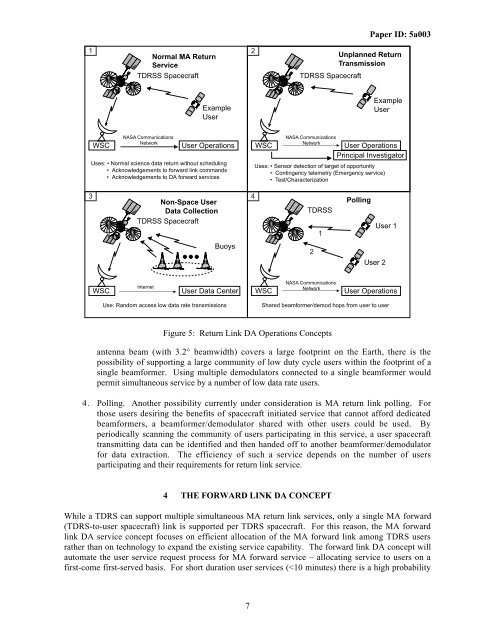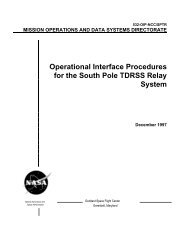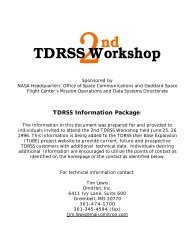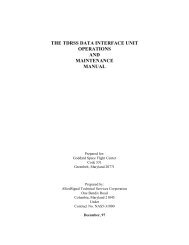TDRSS Demand Access Service: Application of Advanced Technology
TDRSS Demand Access Service: Application of Advanced Technology
TDRSS Demand Access Service: Application of Advanced Technology
You also want an ePaper? Increase the reach of your titles
YUMPU automatically turns print PDFs into web optimized ePapers that Google loves.
1<br />
Normal MA Return<br />
<strong>Service</strong><br />
<strong>TDRSS</strong> Spacecraft<br />
2<br />
NASA Communications<br />
Network<br />
Example<br />
User<br />
WSC User Operations<br />
Uses: • Normal science data return without scheduling<br />
• Acknowledgements to forward link commands<br />
• Acknowledgements to DA forward services<br />
3<br />
Non-Space User<br />
Data Collection<br />
<strong>TDRSS</strong> Spacecraft<br />
4<br />
Internet<br />
Buoys<br />
WSC User Data Center<br />
Use: Random access low data rate transmissions<br />
7<br />
<strong>TDRSS</strong> Spacecraft<br />
Uses: • Sensor detection <strong>of</strong> target <strong>of</strong> opportunity<br />
• Contingency telemetry (Emergency service)<br />
• Test/Characterization<br />
Paper ID: 5a003<br />
antenna beam (with 3.2° beamwidth) covers a large footprint on the Earth, there is the<br />
possibility <strong>of</strong> supporting a large community <strong>of</strong> low duty cycle users within the footprint <strong>of</strong> a<br />
single beamformer. Using multiple demodulators connected to a single beamformer would<br />
permit simultaneous service by a number <strong>of</strong> low data rate users.<br />
4. Polling. Another possibility currently under consideration is MA return link polling. For<br />
those users desiring the benefits <strong>of</strong> spacecraft initiated service that cannot afford dedicated<br />
beamformers, a beamformer/demodulator shared with other users could be used. By<br />
periodically scanning the community <strong>of</strong> users participating in this service, a user spacecraft<br />
transmitting data can be identified and then handed <strong>of</strong>f to another beamformer/demodulator<br />
for data extraction. The efficiency <strong>of</strong> such a service depends on the number <strong>of</strong> users<br />
participating and their requirements for return link service.<br />
4 THE FORWARD LINK DA CONCEPT<br />
Unplanned Return<br />
Transmission<br />
Example<br />
User<br />
WSC<br />
NASA Communications<br />
Network<br />
User Operations<br />
Principal Investigator<br />
<strong>TDRSS</strong><br />
Polling<br />
User 2<br />
User 1<br />
WSC<br />
NASA Communications<br />
Network<br />
User Operations<br />
Shared beamformer/demod hops from user to user<br />
Figure 5: Return Link DA Operations Concepts<br />
While a TDRS can support multiple simultaneous MA return link services, only a single MA forward<br />
(TDRS-to-user spacecraft) link is supported per TDRS spacecraft. For this reason, the MA forward<br />
link DA service concept focuses on efficient allocation <strong>of</strong> the MA forward link among TDRS users<br />
rather than on technology to expand the existing service capability. The forward link DA concept will<br />
automate the user service request process for MA forward service – allocating service to users on a<br />
first-come first-served basis. For short duration user services (






